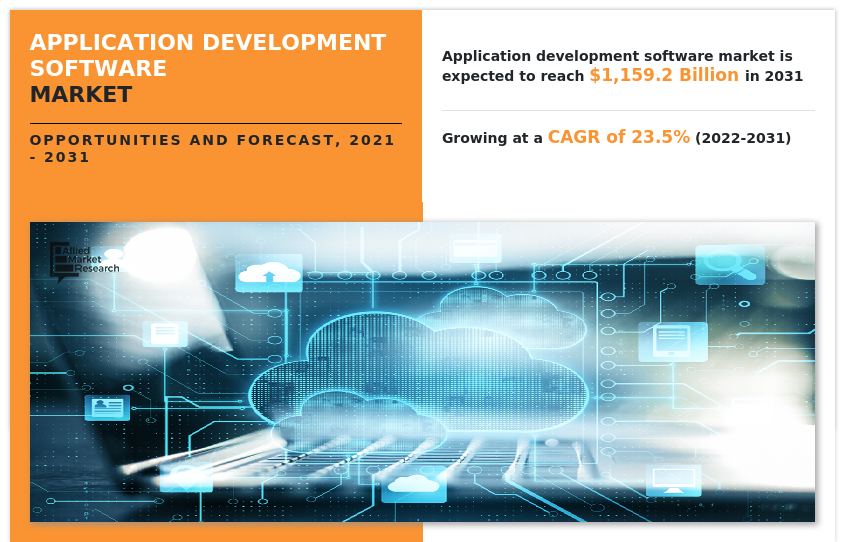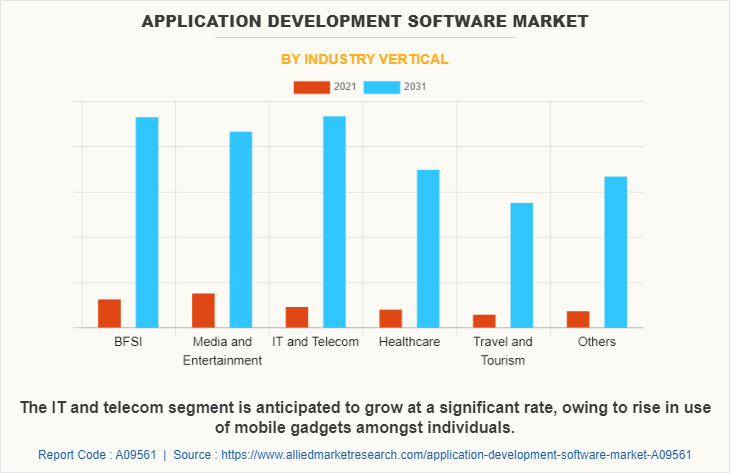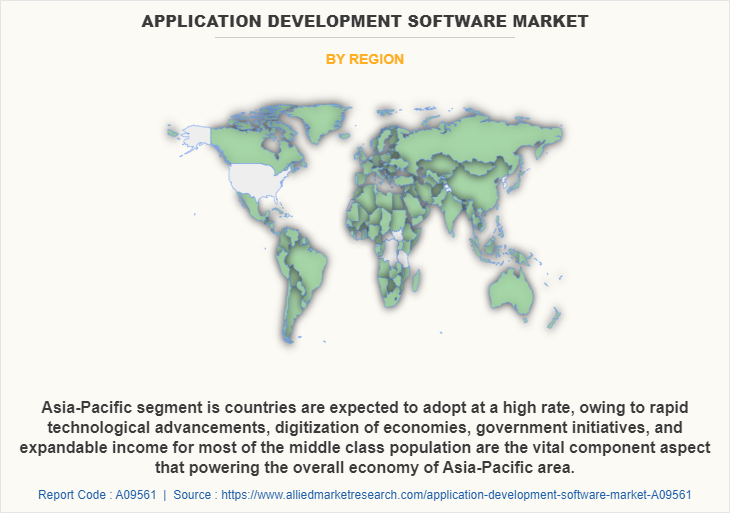Application Development Software Market Research, 2031
The global application development software market size was valued at $142.5 billion in 2021, and is projected to reach $1159.2 billion by 2031, growing at a CAGR of 23.5% from 2022 to 2031.
Machine learning expansion with AutoML and no-code AI and low-code/no-code (LCNC) speeds up software development is boosting the growth of the global application development software market. In addition, big data security is positively impacts growth of the application development software market. However, integrating security and privacy is hampering the application development software market growth. On the contrary, DevSecOps is expected to offer remunerative opportunities for expansion during the application development software market forecast.

Application development software is a series of processes that are used to design, make, install, use, and support computer software. This is often done by computer programmers. Computer software is separate from hardware and can be defined as a collection of instructions or commands that tell a computer to carry out various functions, such as word processing or web browsing applications. It can be done by massive organizations with large teams working on projects, or by a single freelance developer. Application development defines the process of how the application is made, and generally follows a standard methodology. There are lots of factors that go into how application development is done.
The application development software industry is segmented on the basis of platform, deployment model, enterprise size, application, and region. Based on platform, it is segmented into low-code development platforms and no-code development platforms. Based on low-code development platform, it is segmented into platform and services. Based on service, it is segmented into professional services and managed services. Based on deployment model, the market is categorized into on-premise and cloud. Based on enterprise size, the market is categorized into large enterprise and SMEs. Based on application, the market is categorized into BFSI, media & entertainment, IT & telecom, healthcare, travel & tourism, and others. Region wise, it is analyzed across North America, Europe, Asia-Pacific and LAMEA.
The key players operating in the application development software industry include AppSheet, Google Cloud Platform, GitHub, Zoho Creator, Azure, Alice, Snappii Custom Mobile Apps, Twilio Platform, Datadog Cloud Monitoring, Axure RP Wipro Ltd., Fujitsu Ltd., HCL Technologies, Oracle Corporation, SAP SE, Joget, and JetBrains. Furthermore, it highlights the strategies of the key players to improve the market share and sustain competition.
On the basis of industry vertical, the BFSI segment dominated the application development software market share in 2021, and is expected to maintain its dominance in the upcoming years. Adoption of application development software are relied upon to develop at a critical rate owing to development in digitalization of banking exchanges and big data analytics. There is a strong connection between the business objectives of an undertaking and the specialized difficulties it faces while accomplishing them. The modem client is searching for better experience and more prominent personalization Areas including 8FS1 and finch service providers are pushing the envelope for batter client experience.

Depending on the region, North America dominated the application development software market in 2021, as North America is anticipated to account for the largest share of the application development software market during the forecast period, owing to presence of a substantial industrial base in the U.S., government initiatives to promote innovation, and large purchasing power. However, Asia-Pacific is expected to witness significant growth during the forecast period, owing to growing economies such as India and China and cloud native countries like Japan.

Top Impacting Factors
Machine Learning Expansion with AutoML and No-Code AI
Machine learning (ML) has been in the public eye as a disruptive technology impacting various business sectors. Personalized recommendations and ads, image and voice recognition, chatbots and virtual assistants, fraud detection software systems, self-driving cars, and predictive analytics are all examples of the application of practical machine learning. Expectedly, more companies want to introduce ML-based software into their processes and capitalize on it. The challenge is that there are still not enough qualified machine learning specialists to meet the market demand.
Moreover, it can be expensive for a company to hire a full-time ML expert if they only need to adopt a limited set of intelligent functions. AutoML tools make the creation of the machine learning pipeline more simple and transparent. No-code AI software development platforms automatically create ML and AI models and apply them to real-world issues. They have a user-friendly interface, drag-and-drop features and no need to code for the application. Machine learning software development is becoming available to non-technical users and SMBs.
Low-Code/No-Code (LCNC) speeds up software development
Software engineering is moving toward simplification, with a new approach to creating software solutions known as low-code/no-code (LCNC) development. LCNC platforms enable practically anyone to develop software without traditional coding, via graphical user interfaces and configuration. Such programming environments have great potential because they allow people to implement their ideas into digital solutions with limited or no specific software development skills.
While many developers are skeptical about the low-code development approach, it brings a range of benefits such as manual work reduction, time and money savings for creating software solutions, and a lower barrier for entry into software development. Low-code and no-code options can be utilized to complement software development pipelines by allowing users to develop, deploy, and manage some parts of software solutions and delivery pipelines.
Impact of COVID-19
The COVID-19 outbreak has high impact on the growth of application development software market, as increasing number of smartphone users, growing adoption of connected devices, and surging e-commerce sector provide lucrative opportunities for the growth of the application development software market. COVID has caused crises in social, economic, and energy areas and medical life worldwide throughout 2020. This crisis had many direct and indirect effects on all areas of society.
In the meantime, the digital and artificial intelligence industry can be used as a professional assistant to manage and control the outbreak of the virus. In post-pandemic circumstances, enterprises strived to minimize operational and running costs around all the business functions to recover the losses incurred in COVID times. The market for application development software observed unconstructive expansion, during the initial half of 2020. Owing to the limitations due to the global lockdown, media houses, a variety of offices, and the manufacturing divisions have observed a provisional shutting down. The demand for application development software is anticipated to gain steady traction over the coming years owing to the need for scalable and customized software. Due to the COVID-19 pandemic, increasing health awareness among individuals has directed various doctors and health workers to deliver their services over applications. This factor is anticipated to contribute to market growth.
Key Benefits for Stakeholders
- This report provides a quantitative analysis of the market segments, current trends, estimations, and dynamics of the application development software market analysis from 2021 to 2031 to identify the prevailing application development software market opportunities.
- The market research is offered along with information related to key drivers, restraints, and opportunities.
- Porter's five forces analysis highlights the potency of buyers and suppliers to enable stakeholders make profit-oriented business decisions and strengthen their supplier-buyer network.
- In-depth analysis of the application development software market segmentation assists to determine the prevailing market opportunities.
- Major countries in each region are mapped according to their revenue contribution to the global market.
- Market player positioning facilitates benchmarking and provides a clear understanding of the present position of the market players.
- The report includes the analysis of the regional as well as global application development software market trends, key players, market segments, application areas, and market growth strategies.
Application Development Software Market Report Highlights
| Aspects | Details |
| By Platform |
|
| By Deployment Mode |
|
| By Enterprise Size |
|
| By Industry Vertical |
|
| By Region |
|
| Key Market Players | Twilio, Microsoft Corporation, Datadog Cloud Monitoring, Wipro Ltd., GitHub, SAP SE, zoho corporation, Oracle Corporation, Intellij IDEA, Fujitsu Ltd., AppSheet, HCL Technologies Ltd, Google LLC, Joget Workflow |
Analyst Review
In accordance with insights by CXOs of leading companies, one of the current trends in the application development software market that is gaining traction in both developed and emerging economies is the growing need for mobile-based applications. The worldwide application development software market's revenue is being supported by the rise in the number of platforms for developing software applications. SQL Server, Angular.js, React, Node.js, Bootstrap.js, Azure, Web API, iOS, Android, Xamarin, and numerous other platforms are some of the industry's trending technologies.
In the digital era where artificial intelligence and internet of things have taken over the world, there seems to be a comparatively less growth rate of the application development software market than digital marketing. Through various studies it has been observed that application development software market is expanding as a result of the quickening pace of digital transformation in all parts of the world. The use of software application is expanding quickly across all industries since they globally make complex work simpler. With the simplicity with which new businesses may be started and the ease with which organizations can use these enterprises to develop, distribute, and support their products, the growth of the Internet has had a huge impact on the software industry. Consequently, the growing popularity of the Internet is assisting in the growth of the market share for application development software.
Furthermore, machine learning expansion with AutoML and no-code AI and low-code/no-code (LCNC) speeds up software development is boosting the growth of the global application development software market.
Depending on the region, North America dominated the application development software market in 2021, as North America is anticipated to account for the largest share of the application development software market during the forecast period, owing to presence of a substantial industrial base in the U.S., government initiatives to promote innovation, and large purchasing power.
The global application development software market was valued at $142,523.36 million in 2021, and is projected to reach $1,159,179.97 million by 2031, registering a CAGR of 23.5% from 2021 to 2031.
The key players operating in the market include AppSheet, Google Cloud Platform, GitHub, Zoho Creator, Azure, Alice, Snappii Custom Mobile Apps, Twilio Platform, Datadog Cloud Monitoring, Axure RP Wipro Ltd., Fujitsu Ltd., HCL Technologies, Oracle Corporation, SAP SE, Joget, and JetBrains. Furthermore, it highlights the strategies of the key players to improve the market share and sustain competition.
Loading Table Of Content...


